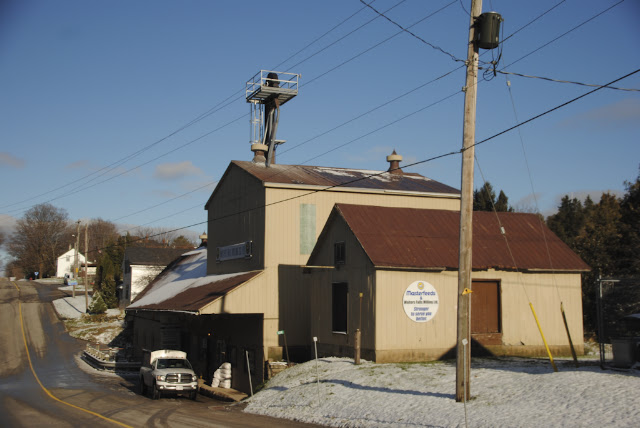I've collected a number of other interesting building here, each with its own interesting story - a power plant, two old mills. a sand dome, and an extra church I didn't share in the last post. In my mind there's something unique about each one, more than my title would suggest.
This is the Eugenia Generating Station, built in 1915. They dammed the Beaver River above the village of Eugenia and fed the water through large wooden stave pipes to the crest of the escarpment, where it hit the surge towers and then plunged to the powerhouse. I'm old enough to remember the enormous wooden pipes, which built huge icicles wherever they leaked. Now the pipes are metal and buried.At the top of the escarpment, these are the surge towers, These function to keep the water pressures as stable as possible, by allowing the water level to rise if pressure increases and fall if pressure decreases. Thus the water pressure entering the generating station down below stays relatively stable. Two large pipes drop right down the slope into the powerhouse, as you can see in the top photo.
And this is the powerhouse, four big generators in a row, taken on a day when they had an open house. It is all run remotely now, from a larger hydro centre, but my uncle worked here in the late 1940s, the uncle I never knew as he died far too young. They had 6 or 8 small houses along the road, and my aunt and cousin also lived here briefly. This hydro plant still makes an important contribution to the electrical grid, partly because it has the highest drop of any hydro plant east of the Rockies.
This building is all that's left of the old sawmill in Walter's Falls, which burned to the ground in 1984, and was rebuilt on the edge of the village where it continues to operate today. I think this building is just used for storage now, but it's a very picturesque setting beside the milldam. The big pipe leading to the waterfalls behind us is a remnant of the old sawmill.
A block up the road is the Walter's Falls grist mill, an honest-to-goodness water-powered feedmill, one of the few left in Ontario. I've had a tour inside and it's simply amazing, a page out of history. I think I'll do another more detailed post just on this old mill. We used to buy bird seed here.
Of course if you live in a cold climate like ours, you need someplace to store the 'pickled sand' they spread on the roads in the winter. A few decades back someone came up with the bright idea of building sand domes. They fill them up in the summer, and trucks stop by in the winter to reload the sand.
If you haven't heard the term 'pickled sand' before, it's a mixture of sand and a small bit of rock salt, which both provides better traction and melts the snow and ice.
Did I mention we live in a cold climate?









This is so interesting, looking at those pipes and the inside. My primary school ( you motivated me to research some details) was opened in 1914, I started there in 1945, and it is still the same main building with additions, a huge hall now and a bigger swimming pool.We drove past in 2012, on our way top a funeral in Auckland. The motto " Character, Kindness, Courtesy" still on the outside timber. Seeing the horse drive sheds, makes me realise how dedicated folks were to attend, by horseback or on a sled or cart, and have their horses shelter during the services.Maybe for some, the only time they met others.
ReplyDeleteLove the photo of the old sawmill!
ReplyDeleteWhat an interesting post. The sawmill looks so photographically appealing, but then there is that pipe.
ReplyDeleteI've never heard of, nor seen a drive shed before. All of the buildings are interesting, and a virtual tour of the grist mill would be great.
ReplyDeleteHere on the prairies the building most ubiquitous in the past were the grain elevators. Most are now gone, torn down in the name of progress.
How times changes.
ReplyDeleteI do like the picture of the old saw mill.
ReplyDeleteAll the best Jan